NCERT Solution for Class 9 Mathematics Chapter 8 - Quadrilaterals Page/Excercise 8.1
Question 1
The angles of quadrilateral are in the ratio 3: 5: 9: 13, Find all the angles of the quadrilateral.
Solution 1
Let the common ratio between the angles is x. So, the angles will be 3x, 5x, 9x and 13x respectively.
Since the sum of all interior angles of a quadrilateral is 360�.
 3x + 5x + 9x + 13x = 360�
3x + 5x + 9x + 13x = 360�
30x = 360�
x = 12�
Hence, the angles are
3x = 3 12 = 36�
12 = 36�
5x = 5 12 = 60�
12 = 60�
9x = 9 12 = 108�
12 = 108�
13x = 13 12 = 156o
12 = 156o
Since the sum of all interior angles of a quadrilateral is 360�.
30x = 360�
x = 12�
Hence, the angles are
3x = 3
 12 = 36�
12 = 36�5x = 5
 12 = 60�
12 = 60�9x = 9
 12 = 108�
12 = 108�13x = 13
 12 = 156o
12 = 156o
Question 2
If the diagonals of a parallelogram are equal, then show that it is a rectangle.
Solution 2
 Let ABCD be a parallelogram. To show ABCD a rectangle, only we need to prove one of its interior angle is 90�.
Let ABCD be a parallelogram. To show ABCD a rectangle, only we need to prove one of its interior angle is 90�.In
 ABC and
ABC and  DCB
DCBAB = DC (opposite sides of a parallelogram are equal)
BC = BC (common)
AC = DB (given)
 ABC
ABC  DCB (by SSS Congruence rule)
DCB (by SSS Congruence rule)  ABC =
ABC =  DCB
DCB We know that sum of measures of angles on the same side of transversal is 180º.
 ABC +
ABC +  DCB = 180� (AB || CD)
DCB = 180� (AB || CD)  ABC +
ABC +  ABC = 180�
ABC = 180�  ABC = 180�
ABC = 180�  ABC = 90�
ABC = 90� Since ABCD is a parallelogram and one of its interior angles is 90�, therefore, ABCD is rectangle.
Question 3
Show that if the diagonals of a quadrilateral bisect each other at right angles, then it is a rhombus.
Solution 3
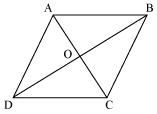 Let ABCD be a quadrilateral, whose diagonals AC and BD bisect each other at right angle
Let ABCD be a quadrilateral, whose diagonals AC and BD bisect each other at right anglei.e. OA = OC, OB = OD and
 AOB =
AOB =  BOC =
BOC =  COD =
COD =  AOD = 90�
AOD = 90�To prove ABCD a rhombus, we need to prove ABCD is a parallelogram and all sides of ABCD are equal.
Now, in
 AOD and
AOD and  COD
CODOA = OC (Diagonal bisects each other)
 AOD =
AOD =  COD (given)
COD (given)OD = OD (common)
 AOD
AOD COD (by SAS congruence rule)
COD (by SAS congruence rule) Similarly we can prove that
AD = AB and CD = BC (2)
From equations (1) and (2), we can say that
AB = BC = CD = AD
Since opposite sides of quadrilateral ABCD are equal, so, we can say that ABCD is a parallelogram. Since all sides of a parallelogram ABCD are equal, so, we can say that ABCD is a rhombus.
Question 4
Show that the diagonals of a square are equal and bisect each other at right angles.
Solution 4
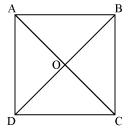 Let ABCD be a square. Let the diagonals AC and BD intersect each other at a point O.
Let ABCD be a square. Let the diagonals AC and BD intersect each other at a point O.To show diagonals of a square are equal and bisect each other at right angles, we need to prove AC = BD, OA = OC, OB = OD and
 AOB = 90�
AOB = 90� Now, in
 ABC and
ABC and  DCB
DCBAB = DC (sides of square are equal to each other)
 ABC =
ABC =  DCB (all interior angles are of 90 )
DCB (all interior angles are of 90 )BC = BC (common side)
 ABC
ABC DCB (by SAS congruency)
DCB (by SAS congruency) Now in
 AOB and
AOB and  COD
COD AOB =
AOB =  COD (vertically opposite angles)
COD (vertically opposite angles) ABO =
ABO =  CDO (alternate interior angles)
CDO (alternate interior angles)AB = CD (sides of square are always equal)
 AOB
AOB  COD (by AAS congruence rule)
COD (by AAS congruence rule) Hence, the diagonals of a square bisect each other
Now in
 AOB and
AOB and  COB
COBNow as we had proved that diagonals bisect each other
So, AO = CO
AB = CB (sides of square are equal)
BO = BO (common)
 AOB
AOB COB (by SSS congruence)
COB (by SSS congruence) AOB =
AOB =  COB (by CPCT)
COB (by CPCT) But,
 AOB +
AOB +  COB = 180� (linear pair)
COB = 180� (linear pair)2
 AOB = 180�
AOB = 180� AOB = 90�
AOB = 90� Hence, the diagonals of a square bisect each other at right angle.
Question 5
Show that if the diagonals of a quadrilateral are equal and bisect each other at right angles, then it is a square.
Solution 5
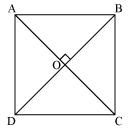 Let us consider a quadrilateral ABCD in which the diagonals AC and BD intersect each other at O.
Let us consider a quadrilateral ABCD in which the diagonals AC and BD intersect each other at O. Given that the diagonals of ABCD are equal and bisect each other at right angles. So, AC = BD, OA = OC, OB = OD and
 AOB =
AOB =  BOC =
BOC =  COD =
COD =  AOD = 90�.
AOD = 90�. To prove ABCD a square, we need to prove ABCD is a parallelogram, AB = BC = CD = AD and one of its interior angle is 90�.
Now, in
 AOB and
AOB and  COD
CODAO = CO (Diagonals bisect each other)
OB = OD (Diagonals bisect each other)
 AOB =
AOB =  COD (Vertically opposite angles)
COD (Vertically opposite angles) AOB
AOB  COD (SAS congruence rule)
COD (SAS congruence rule)And
 OAB =
OAB =  OCD (by CPCT)
OCD (by CPCT)But these are alternate interior angles for line AB and CD and alternate interior angle are equal to each other only when the two lines are parallel
From equations (1) and (2), we have
ABCD is a parallelogram
Now, in
 AOD and
AOD and  COD
CODAO = CO (Diagonals bisect each other)
 AOD =
AOD =  COD (Given that each is 90�)
COD (Given that each is 90�)OD = OD (common)
 AOD
AOD 
 COD (SAS congruence rule)
COD (SAS congruence rule) But, AD = BC and AB = CD (opposite sides of parallelogram ABCD)
So, all the sides quadrilateral ABCD are equal to each other
Now, in
 ADC and
ADC and  BCD
BCDAD = BC (Already proved)
AC = BD (given)
DC = CD (Common)
 ADC
ADC  BCD (SSS Congruence rule)
BCD (SSS Congruence rule) ADC =
ADC =  BCD (by CPCT) But
BCD (by CPCT) But  ADC +
ADC +  BCD = 180o (co-interior angles)
BCD = 180o (co-interior angles)  ADC +
ADC +  ADC = 180o
ADC = 180o ADC = 180o
ADC = 180o ADC = 90o
ADC = 90o One of interior angle of ABCD quadrilateral is a right angle
Now, we have ABCD is a parallelogram, AB = BC = CD = AD and one of its interior angle is 90�. Therefore, ABCD is a square.
Question 6
Diagonal AC of a parallelogram ABCD bisects  A (see the given figure). Show that (i) It bisects
A (see the given figure). Show that (i) It bisects  C also; (ii) ABCD is a rhombus.
C also; (ii) ABCD is a rhombus. 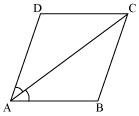
 A (see the given figure). Show that (i) It bisects
A (see the given figure). Show that (i) It bisects  C also; (ii) ABCD is a rhombus.
C also; (ii) ABCD is a rhombus. 
Solution 6
(i) ABCD is a parallelogram.

 DAC =
DAC =  BCA (Alternate interior angles) ... (1) And
BCA (Alternate interior angles) ... (1) And  BAC =
BAC =  DCA (Alternate interior angles) ... (2)
DCA (Alternate interior angles) ... (2)
But it is given that AC bisects A.
A.

 DAC =
DAC =  BAC ... (3) From equations (1), (2) and (3), we have
BAC ... (3) From equations (1), (2) and (3), we have
 DAC =
DAC =  BCA =
BCA =  BAC =
BAC =  DCA ... (4)
DCA ... (4)
 DCA =
DCA =  BCA
BCA
Hence, AC bisects C.
C.
(ii) From equation (4), we have
 DAC =
DAC =  DCA
DCA
 DA = DC (side opposite to equal angles are equal)
DA = DC (side opposite to equal angles are equal)
But DA = BC and AB = CD (opposite sides of parallelogram)
 AB = BC = CD = DA Hence, ABCD is rhombus
AB = BC = CD = DA Hence, ABCD is rhombus
 DAC =
DAC =  BCA (Alternate interior angles) ... (1) And
BCA (Alternate interior angles) ... (1) And  BAC =
BAC =  DCA (Alternate interior angles) ... (2)
DCA (Alternate interior angles) ... (2) But it is given that AC bisects
 A.
A.  DAC =
DAC =  BAC ... (3) From equations (1), (2) and (3), we have
BAC ... (3) From equations (1), (2) and (3), we have DAC =
DAC =  BCA =
BCA =  BAC =
BAC =  DCA ... (4)
DCA ... (4)  DCA =
DCA =  BCA
BCA Hence, AC bisects
 C.
C.(ii) From equation (4), we have
 DAC =
DAC =  DCA
DCA But DA = BC and AB = CD (opposite sides of parallelogram)
Question 7
ABCD is a rhombus. Show that diagonal AC bisects  A as well as
A as well as  C and diagonal BD bisects
C and diagonal BD bisects  B as well as
B as well as  D.
D.
 A as well as
A as well as  C and diagonal BD bisects
C and diagonal BD bisects  B as well as
B as well as  D.
D.
Solution 7
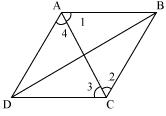 Let us join AC
Let us join ACIn
 ABC
ABCBC = AB (side of a rhombus are equal to each other)
 1 =
1 =  2 (angles opposite to equal sides of a triangle are equal)
2 (angles opposite to equal sides of a triangle are equal) But
 1 =
1 =  3 (alternate interior angles for parallel lines AB and CD)
3 (alternate interior angles for parallel lines AB and CD)  2 =
2 = 3
3 So, AC bisects
 C.
C. Also,
 2 =
2 =  4 (alternate interior angles for || lines BC and DA)
4 (alternate interior angles for || lines BC and DA)  1 =
1 =  4
4 So, AC bisects
 A
A Similarly, we can prove that BD bisects B and D as well.
Question 8
ABCD is a rectangle in which diagonal AC bisects  A as well as
A as well as  C. Show that:
C. Show that:
(i) ABCD is a square (ii) diagonal BD bisects  B as well as
B as well as  D
D
 A as well as
A as well as  C. Show that:
C. Show that:(i) ABCD is a square (ii) diagonal BD bisects
 B as well as
B as well as  D
D
Solution 8
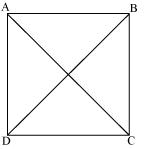 (i) Given that AC is bisector of
(i) Given that AC is bisector of  A and
A and  C.
C.Or
 DAC =
DAC =  DCA
DCA CD = DA (sides opposite to equal angles are also equal)
But DA = BC and AB = CD (opposite sides of rectangle are equal)
Hence, ABCD is a square (ii) Let us join BD
In
 BCD
BCDBC = CD (side of a square are equal to each other)
 CDB =
CDB =  CBD (angles opposite to equal sides are equal)
CBD (angles opposite to equal sides are equal) But
 CDB =
CDB =  ABD (alternate interior angles for AB || CD)
ABD (alternate interior angles for AB || CD) CBD =
CBD =  ABD
ABD  BD bisects
BD bisects  B.
B. Also
 CBD =
CBD =  ADB (alternate interior angles for BC || AD)
ADB (alternate interior angles for BC || AD) CDB =
CDB =  ADB
ADB
Question 9
In parallelogram ABCD, two points P and Q are taken on diagonal BD such that DP = BQ (see the given figure). Show that: 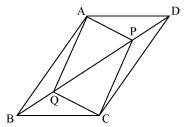 (i)
(i)  APD
APD CQB
CQB
(ii) AP = CQ
(iii)  AQB
AQB CPD
CPD
(iv) AQ = CP
(v) APCQ is a parallelogram
 (i)
(i)  APD
APD CQB
CQB (ii) AP = CQ
(iii)
 AQB
AQB CPD
CPD(iv) AQ = CP
(v) APCQ is a parallelogram
Solution 9
(i) In  APD and
APD and  CQB
CQB
 ADP =
ADP =  CBQ (alternate interior angles for BC || AD)
CBQ (alternate interior angles for BC || AD)
AD = CB (opposite sides of parallelogram ABCD)
DP = BQ (given)

 APD
APD  CQB (using SAS congruence rule)
CQB (using SAS congruence rule)
(ii) As we had observed that APD
APD  CQB
CQB
 AP = CQ (CPCT) (iii) In
AP = CQ (CPCT) (iii) In  AQB and
AQB and  CPD
CPD
 ABQ =
ABQ =  CDP (alternate interior angles for AB || CD)
CDP (alternate interior angles for AB || CD)
AB = CD (opposite sides of parallelogram ABCD)
BQ = DP (given)

 AQB CPD (using SAS congruence rule)
AQB CPD (using SAS congruence rule)
(iv) As we had observed that AQB
AQB CPD
CPD
 AQ = CP (CPCT)
AQ = CP (CPCT)
(v) From the result obtained in (ii) and (iv), we have
AQ = CP and AP = CQ
Since opposite sides in quadrilateral APCQ are equal to each other. So, APCQ is a parallelogram.
 APD and
APD and  CQB
CQB ADP =
ADP =  CBQ (alternate interior angles for BC || AD)
CBQ (alternate interior angles for BC || AD) AD = CB (opposite sides of parallelogram ABCD)
DP = BQ (given)
 APD
APD  CQB (using SAS congruence rule)
CQB (using SAS congruence rule) (ii) As we had observed that
 APD
APD  CQB
CQB  AQB and
AQB and  CPD
CPD ABQ =
ABQ =  CDP (alternate interior angles for AB || CD)
CDP (alternate interior angles for AB || CD)AB = CD (opposite sides of parallelogram ABCD)
BQ = DP (given)
 AQB CPD (using SAS congruence rule)
AQB CPD (using SAS congruence rule) (iv) As we had observed that
 AQB
AQB CPD
CPD (v) From the result obtained in (ii) and (iv), we have
AQ = CP and AP = CQ
Since opposite sides in quadrilateral APCQ are equal to each other. So, APCQ is a parallelogram.
Question 10
ABCD is a parallelogram and AP and CQ are perpendiculars from vertices A and C on diagonal BD (See the given figure). Show that 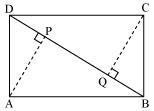 (i)
(i)  APB
APB  CQD
CQD
(ii) AP = CQ
 (i)
(i)  APB
APB  CQD
CQD (ii) AP = CQ
Solution 10
(i) In  APB and
APB and  CQD
CQD
 APB =
APB =  CQD (each 90o)
CQD (each 90o)
AB = CD (opposite sides of parallelogram ABCD)
 ABP =
ABP =  CDQ (alternate interior angles for AB || CD)
CDQ (alternate interior angles for AB || CD)
 APB
APB  CQD (by AAS congruency)
CQD (by AAS congruency)
(ii) By using the result obtained as above
 APB
APB  CQD, we have
CQD, we have
AP = CQ (by CPCT)
 APB and
APB and  CQD
CQD APB =
APB =  CQD (each 90o)
CQD (each 90o) AB = CD (opposite sides of parallelogram ABCD)
 ABP =
ABP =  CDQ (alternate interior angles for AB || CD)
CDQ (alternate interior angles for AB || CD)  CQD (by AAS congruency)
CQD (by AAS congruency) (ii) By using the result obtained as above
 APB
APB  CQD, we have
CQD, we have AP = CQ (by CPCT)
Question 11
In  ABC and
ABC and  DEF, AB = DE, AB || DE, BC = EF and BC || EF. Vertices A, B and C are joined to vertices D, E and F respectively (see the given figure). Show that
DEF, AB = DE, AB || DE, BC = EF and BC || EF. Vertices A, B and C are joined to vertices D, E and F respectively (see the given figure). Show that 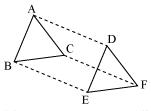 (i) Quadrilateral ABED is a parallelogram
(i) Quadrilateral ABED is a parallelogram
(ii) Quadrilateral BEFC is a parallelogram
(iii) AD || CF and AD = CF
(iv) Quadrilateral ACFD is a parallelogram
(v) AC = DF
(vi)  ABC
ABC DEF
DEF
 ABC and
ABC and  DEF, AB = DE, AB || DE, BC = EF and BC || EF. Vertices A, B and C are joined to vertices D, E and F respectively (see the given figure). Show that
DEF, AB = DE, AB || DE, BC = EF and BC || EF. Vertices A, B and C are joined to vertices D, E and F respectively (see the given figure). Show that  (i) Quadrilateral ABED is a parallelogram
(i) Quadrilateral ABED is a parallelogram (ii) Quadrilateral BEFC is a parallelogram
(iii) AD || CF and AD = CF
(iv) Quadrilateral ACFD is a parallelogram
(v) AC = DF
(vi)
 ABC
ABC DEF
DEF
Solution 11
(i) Here AB = DE and AB || DE.
Now, if two opposite sides of a quadrilateral are equal and parallel to each other, it will be a parallelogram.
Therefore, quadrilateral ABED is a parallelogram.
(ii) Again BC = EF and BC || EF.
Therefore, quadrilateral BEFC is a parallelogram. (iii) Here ABED and BEFC are parallelograms.
AD = BE, and AD || BE
(Opposite sides of parallelogram are equal and parallel)
And BE = CF, and BE || CF
(Opposite sides of parallelogram are equal and parallel)
 AD = CF, and AD || CF
AD = CF, and AD || CF
(iv) Here one pair of opposite sides (AD and CF) of quadrilateral ACFD are equal and parallel to each other,
so, it is a parallelogram.
(v) As ACFD is a parallelogram, so, pair of opposite sides will be equal and parallel to each other.
 AC || DF and AC = DF
AC || DF and AC = DF
(vi) ABC and
ABC and  DEF.
DEF.
AB = DE (given)
BC = EF (given)
AC = DF (ACFD is a parallelogram)

 ABC
ABC DEF (by SSS congruence rule)
DEF (by SSS congruence rule)
Now, if two opposite sides of a quadrilateral are equal and parallel to each other, it will be a parallelogram.
Therefore, quadrilateral ABED is a parallelogram.
(ii) Again BC = EF and BC || EF.
Therefore, quadrilateral BEFC is a parallelogram. (iii) Here ABED and BEFC are parallelograms.
AD = BE, and AD || BE
(Opposite sides of parallelogram are equal and parallel)
And BE = CF, and BE || CF
(Opposite sides of parallelogram are equal and parallel)
(iv) Here one pair of opposite sides (AD and CF) of quadrilateral ACFD are equal and parallel to each other,
so, it is a parallelogram.
(v) As ACFD is a parallelogram, so, pair of opposite sides will be equal and parallel to each other.
(vi)
 ABC and
ABC and  DEF.
DEF.AB = DE (given)
BC = EF (given)
AC = DF (ACFD is a parallelogram)
 ABC
ABC DEF (by SSS congruence rule)
DEF (by SSS congruence rule)
Question 12
ABCD is a trapezium in which AB || CD and AD = BC (see the given figure). Show that
 (i)
(i)  A =
A =  B
B
(ii)  C =
C =  D
D
(iii)  ABC
ABC  BAD
BAD
(iv) Diagonal AC = diagonal BD
 (i)
(i)  A =
A =  B
B (ii)
 C =
C =  D
D(iii)
 ABC
ABC  BAD
BAD(iv) Diagonal AC = diagonal BD
Solution 12
Extend AB. Draw a line through C, which is parallel to AD, intersecting AE at point E.
Now, AECD is a parallelogram.
(i) AD = CE (opposite sides of parallelogram AECD)
But AD = BC (given)
So, BC = CE
 CEB =
CEB =  CBE (angle opposite to equal sides are also equal)
CBE (angle opposite to equal sides are also equal)
Now consider parallel lines AD and CE. AE is transversal line for them
 A +
A +  CEB = 180� (angles on the same side of transversal)
CEB = 180� (angles on the same side of transversal)
 A+
A+  CBE = 180� (using the relation
CBE = 180� (using the relation CEB =
CEB =  CBE) ... (1)
CBE) ... (1)
But B +
B +  CBE = 180� (linear pair angles) ... (2)
CBE = 180� (linear pair angles) ... (2)
From equations (1) and (2), we have
 A =
A =  B
B
(ii) AB || CD
 A +
A +  D = 180� (angles on the same side of transversal)
D = 180� (angles on the same side of transversal)
Also C +
C +  B = 180 (angles on the same side of transversal)
B = 180 (angles on the same side of transversal)

 A +
A +  D =
D =  C +
C +  B
B
But A =
A =  B [using the result obtained proved in (i)]
B [using the result obtained proved in (i)]

 C =
C =  D
D
(iii) In ABC and BAD
AB = BA (common side)
BC = AD (given)
 B =
B =  A (proved before)
A (proved before)

 ABC
ABC  BAD (SAS congruence rule)
BAD (SAS congruence rule)
(iv) ABC
ABC BAD
BAD
 AC = BD (by CPCT)
AC = BD (by CPCT)
Now, AECD is a parallelogram.
(i) AD = CE (opposite sides of parallelogram AECD)
But AD = BC (given)
So, BC = CE
 CEB =
CEB =  CBE (angle opposite to equal sides are also equal)
CBE (angle opposite to equal sides are also equal) Now consider parallel lines AD and CE. AE is transversal line for them
 A +
A +  CEB = 180� (angles on the same side of transversal)
CEB = 180� (angles on the same side of transversal) A+
A+  CBE = 180� (using the relation
CBE = 180� (using the relation CEB =
CEB =  CBE) ... (1)
CBE) ... (1) But
 B +
B +  CBE = 180� (linear pair angles) ... (2)
CBE = 180� (linear pair angles) ... (2) From equations (1) and (2), we have
 A =
A =  B
B (ii) AB || CD
 A +
A +  D = 180� (angles on the same side of transversal)
D = 180� (angles on the same side of transversal) Also
 C +
C +  B = 180 (angles on the same side of transversal)
B = 180 (angles on the same side of transversal)  A +
A +  D =
D =  C +
C +  B
B But
 A =
A =  B [using the result obtained proved in (i)]
B [using the result obtained proved in (i)] C =
C =  D
D (iii) In ABC and BAD
AB = BA (common side)
BC = AD (given)
 B =
B =  A (proved before)
A (proved before)  ABC
ABC  BAD (SAS congruence rule)
BAD (SAS congruence rule) (iv)
 ABC
ABC BAD
BAD NCERT Solution for Class 9 Mathematics Chapter 8 - Quadrilaterals Page/Excercise 8.2
Question 1
ABCD is a quadrilateral in which P, Q, R and S are mid-points of the sides AB, BC, CD and DA (see the given figure). AC is a diagonal. Show that: 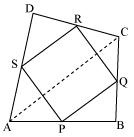 (i) SR || AC and SR =
(i) SR || AC and SR =  AC
AC
(ii) PQ = SR
(iii) PQRS is a parallelogram.
 (i) SR || AC and SR =
(i) SR || AC and SR =  AC
AC (ii) PQ = SR
(iii) PQRS is a parallelogram.
Solution 1
(i) In  ADC, S and R are the mid points of sides AD and CD respectively.
ADC, S and R are the mid points of sides AD and CD respectively.
In a triangle the line segment joining the mid points of any two sides of the triangle is parallel to the third side and is half of it.
 SR || AC and SR =
SR || AC and SR =  AC ... (1)
AC ... (1)
(ii) In ABC, P and Q are mid points of sides AB and BC respectively. So, by using mid-point theorem, we have
PQ || AC and PQ = AC ... (2)
AC ... (2)
Now using equations (1) and (2), we have
PQ || SR and PQ = SR ... (3)
 PQ = SR
PQ = SR
(iii) From equations (3), we have
PQ || SR and PQ = SR
Clearly one pair of opposite sides of quadrilateral PQRS is parallel and equal
Hence, PQRS is a parallelogram.
 ADC, S and R are the mid points of sides AD and CD respectively.
ADC, S and R are the mid points of sides AD and CD respectively.In a triangle the line segment joining the mid points of any two sides of the triangle is parallel to the third side and is half of it.
 AC ... (1)
AC ... (1) (ii) In ABC, P and Q are mid points of sides AB and BC respectively. So, by using mid-point theorem, we have
PQ || AC and PQ =
 AC ... (2)
AC ... (2) Now using equations (1) and (2), we have
PQ || SR and PQ = SR ... (3)
 PQ = SR
PQ = SR(iii) From equations (3), we have
PQ || SR and PQ = SR
Clearly one pair of opposite sides of quadrilateral PQRS is parallel and equal
Hence, PQRS is a parallelogram.
Question 2
ABCD is a rhombus and P, Q, R and S are the mid-points of the sides AB, BC, CD and DA respectively. Show that the quadrilateral PQRS is a rectangle.
Solution 2
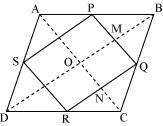 In
In  ABC, P and Q are mid points of sides AB and BC respectively.
ABC, P and Q are mid points of sides AB and BC respectively. AC (using mid-point theorem) ... (1)
AC (using mid-point theorem) ... (1) In
 ADC
ADCR and S are the mid points of CD and AD respectively
 AC (using mid-point theorem) ... (2)
AC (using mid-point theorem) ... (2) From equations (1) and (2), we have
PQ || RS and PQ = RS
As in quadrilateral PQRS one pair of opposite sides are equal and parallel to each other, so, it is a parallelogram.
Let diagonals of rhombus ABCD intersect each other at point O.
Now in quadrilateral OMQN
MQ || ON (
QN || OM (
So, OMQN is parallelogram
 MQN =
MQN =  NOM
NOM PQR =
PQR =  NOM
NOM But,
 NOM = 90o (diagonals of a rhombus are perpendicular to each other)
NOM = 90o (diagonals of a rhombus are perpendicular to each other) PQR = 90o
PQR = 90o Clearly PQRS is a parallelogram having one of its interior angle as 90�.
Hence, PQRS is rectangle.
Question 3
ABCD is a rectangle and P, Q, R and S are mid-points of the sides AB, BC, CD and DA respectively. Show that the quadrilateral PQRS is a rhombus
Solution 3
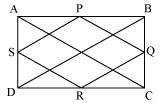 Let us join AC and BD
Let us join AC and BDIn
 ABC
ABCP and Q are the mid-points of AB and BC respectively
 AC (mid point theorem) ... (1)
AC (mid point theorem) ... (1) Similarly in
 ADC
ADCSR || AC and SR =
 AC (mid point theorem) ... ... (2)
AC (mid point theorem) ... ... (2) Clearly, PQ || SR and PQ = SR
As in quadrilateral PQRS one pair of opposite sides is equal and parallel to
each other, so, it is a parallelogram.
Now, in
 BCD, Q and R are mid points of side BC and CD respectively.
BCD, Q and R are mid points of side BC and CD respectively. BD (mid point theorem) ... (4)
BD (mid point theorem) ... (4) But diagonals of a rectangle are equal
Now, by using equation (1), (2), (3), (4), (5) we can say that
PQ = QR = SR = PS
So, PQRS is a rhombus.
Question 4
ABCD is a trapezium in which AB || DC, BD is a diagonal and E is the mid - point of AD. A line is drawn through E parallel to AB intersecting BC at F (see the given figure). Show that F is the mid-point of BC. 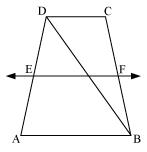

Solution 4
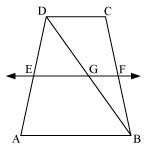 By converse of mid-point theorem a line drawn, through the mid point of any side of a triangle and parallel to another side bisects the third side.
By converse of mid-point theorem a line drawn, through the mid point of any side of a triangle and parallel to another side bisects the third side. Now in
 ABD
ABDEF || AB and E is mid-point of AD
So, this line will intersect BD at point G and G will be the mid-point of DB.
Now as EF || AB and AB || CD
 BCD, GF || CD and G is the midpoint of line BD. So, by using converse of mid-point theorem, F is the mid-point of BC.
BCD, GF || CD and G is the midpoint of line BD. So, by using converse of mid-point theorem, F is the mid-point of BC.
Question 5
In a parallelogram ABCD, E and F are the mid-points of sides AB and CD respectively (see the given figure). Show that the line segments AF and EC trisect the diagonal BD. 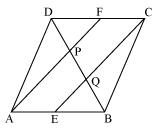

Solution 5
ABCD is a parallelogram
 AB || CD
AB || CD
So, AE || FC
Again AB = CD (opposite sides of parallelogram ABCD)
 AB =
AB =  CD
CD
AE = FC (E and F are midpoints of side AB and CD)
As in quadrilateral AECF one pair of opposite sides (AE and CF) are parallel and equal to each other. So, AECF is a parallelogram.
 AF || EC (Opposite sides of a parallelogram)
AF || EC (Opposite sides of a parallelogram)
Now, in DQC, F is mid point of side DC and FP || CQ (as AF || EC). So, by using converse of mid-point theorem, we can say that
DQC, F is mid point of side DC and FP || CQ (as AF || EC). So, by using converse of mid-point theorem, we can say that
P is the mid-point of DQ
 DP = PQ ... (1)
DP = PQ ... (1)
Similarly, in APB, E is mid point of side AB and EQ || AP (as AF || EC). So, by using converse of mid-point theorem, we can say that
APB, E is mid point of side AB and EQ || AP (as AF || EC). So, by using converse of mid-point theorem, we can say that
Q is the mid-point of PB
 PQ = QB ... (2)
PQ = QB ... (2)
From equations (1) and (2), we may say that
DP = PQ = BQ
Hence, the line segments AF and EC trisect the diagonal BD.
So, AE || FC
Again AB = CD (opposite sides of parallelogram ABCD)
 AB =
AB =  CD
CD AE = FC (E and F are midpoints of side AB and CD)
As in quadrilateral AECF one pair of opposite sides (AE and CF) are parallel and equal to each other. So, AECF is a parallelogram.
 AF || EC (Opposite sides of a parallelogram)
AF || EC (Opposite sides of a parallelogram) Now, in
 DQC, F is mid point of side DC and FP || CQ (as AF || EC). So, by using converse of mid-point theorem, we can say that
DQC, F is mid point of side DC and FP || CQ (as AF || EC). So, by using converse of mid-point theorem, we can say thatP is the mid-point of DQ
 DP = PQ ... (1)
DP = PQ ... (1) Similarly, in
 APB, E is mid point of side AB and EQ || AP (as AF || EC). So, by using converse of mid-point theorem, we can say that
APB, E is mid point of side AB and EQ || AP (as AF || EC). So, by using converse of mid-point theorem, we can say thatQ is the mid-point of PB
 PQ = QB ... (2)
PQ = QB ... (2) From equations (1) and (2), we may say that
DP = PQ = BQ
Hence, the line segments AF and EC trisect the diagonal BD.
Question 6
Show that the line segments joining the mid-points of the opposite sides of a quadrilateral bisect each other.
Solution 6
 Let ABCD is a quadrilateral in which P, Q, R and S are mid-points of sides AB, BC, CD and DA respectively.
Let ABCD is a quadrilateral in which P, Q, R and S are mid-points of sides AB, BC, CD and DA respectively.Join PQ, QR, RS, SP and BD.
In
 ABD, S and P are mid points of AD and AB respectively.
ABD, S and P are mid points of AD and AB respectively. So, By using mid-point theorem, we can say that
SP || BD and SP =
 BD ... (1)
BD ... (1) Similarly in
 BCD
BCDQR || BD and QR =
 BD ... (2)
BD ... (2) From equations (1) and (2), we have
SP || QR and SP = QR
As in quadrilateral SPQR one pair of opposite sides are equal and parallel to
each other.
So, SPQR is a parallelogram. Since, diagonals of a parallelogram bisect each other.
Hence, PR and QS bisect each other.
Question 7
ABC is a triangle right angled at C. A line through the mid-point M of hypotenuse AB and parallel to BC intersects AC at D. Show that
(i) D is the mid-point of AC
(ii) MD  AC
AC
(iii) CM=MA= AB
AB
(i) D is the mid-point of AC
(ii) MD
 AC
AC(iii) CM=MA=
 AB
AB
Solution 7
 (i) In
(i) In  ABC
ABCGiven that M is mid point of AB and MD || BC.
So, D is the mid-point of AC. (Converse of mid-point theorem)
(ii) As DM || CB and AC is a transversal line for them.
So,
 MDC +
MDC +  DCB = 180� (Co-interior angles)
DCB = 180� (Co-interior angles)  MDC + 90� = 180�
MDC + 90� = 180� MDC = 90�
MDC = 90� AC (iii) Join MC
AC (iii) Join MC  In
In  AMD and
AMD and  CMD
CMD AD = CD (D is the midpoint of side AC)
 ADM =
ADM =  CDM (Each 90�)
CDM (Each 90�)DM = DM (common)
 AMD
AMD CMD (by SAS congruence rule) So, AM = CM (by CPCT)
CMD (by SAS congruence rule) So, AM = CM (by CPCT)But AM =
 AB (M is mid point of AB)
AB (M is mid point of AB)So, CM = MA =
 AB
AB
No comments:
Post a Comment